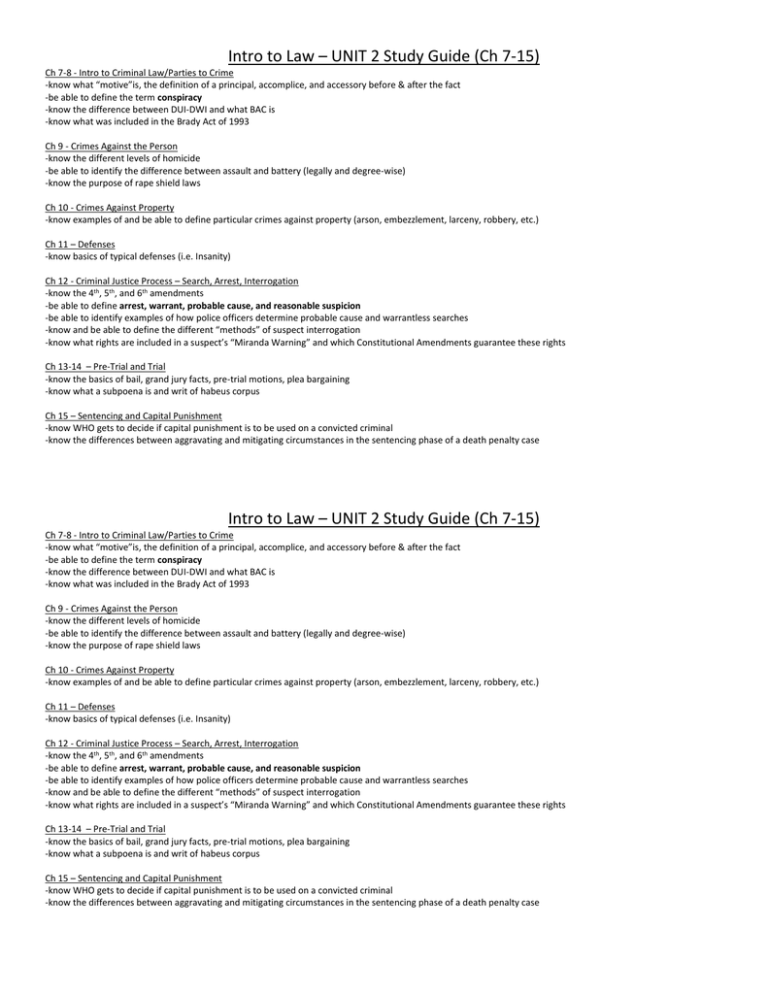unit 2 review sheet
advertisement

Intro to Law – UNIT 2 Study Guide (Ch 7-15) Ch 7-8 - Intro to Criminal Law/Parties to Crime -know what “motive”is, the definition of a principal, accomplice, and accessory before & after the fact -be able to define the term conspiracy -know the difference between DUI-DWI and what BAC is -know what was included in the Brady Act of 1993 Ch 9 - Crimes Against the Person -know the different levels of homicide -be able to identify the difference between assault and battery (legally and degree-wise) -know the purpose of rape shield laws Ch 10 - Crimes Against Property -know examples of and be able to define particular crimes against property (arson, embezzlement, larceny, robbery, etc.) Ch 11 – Defenses -know basics of typical defenses (i.e. Insanity) Ch 12 - Criminal Justice Process – Search, Arrest, Interrogation -know the 4th, 5th, and 6th amendments -be able to define arrest, warrant, probable cause, and reasonable suspicion -be able to identify examples of how police officers determine probable cause and warrantless searches -know and be able to define the different “methods” of suspect interrogation -know what rights are included in a suspect’s “Miranda Warning” and which Constitutional Amendments guarantee these rights Ch 13-14 – Pre-Trial and Trial -know the basics of bail, grand jury facts, pre-trial motions, plea bargaining -know what a subpoena is and writ of habeus corpus Ch 15 – Sentencing and Capital Punishment -know WHO gets to decide if capital punishment is to be used on a convicted criminal -know the differences between aggravating and mitigating circumstances in the sentencing phase of a death penalty case Intro to Law – UNIT 2 Study Guide (Ch 7-15) Ch 7-8 - Intro to Criminal Law/Parties to Crime -know what “motive”is, the definition of a principal, accomplice, and accessory before & after the fact -be able to define the term conspiracy -know the difference between DUI-DWI and what BAC is -know what was included in the Brady Act of 1993 Ch 9 - Crimes Against the Person -know the different levels of homicide -be able to identify the difference between assault and battery (legally and degree-wise) -know the purpose of rape shield laws Ch 10 - Crimes Against Property -know examples of and be able to define particular crimes against property (arson, embezzlement, larceny, robbery, etc.) Ch 11 – Defenses -know basics of typical defenses (i.e. Insanity) Ch 12 - Criminal Justice Process – Search, Arrest, Interrogation -know the 4th, 5th, and 6th amendments -be able to define arrest, warrant, probable cause, and reasonable suspicion -be able to identify examples of how police officers determine probable cause and warrantless searches -know and be able to define the different “methods” of suspect interrogation -know what rights are included in a suspect’s “Miranda Warning” and which Constitutional Amendments guarantee these rights Ch 13-14 – Pre-Trial and Trial -know the basics of bail, grand jury facts, pre-trial motions, plea bargaining -know what a subpoena is and writ of habeus corpus Ch 15 – Sentencing and Capital Punishment -know WHO gets to decide if capital punishment is to be used on a convicted criminal -know the differences between aggravating and mitigating circumstances in the sentencing phase of a death penalty case






